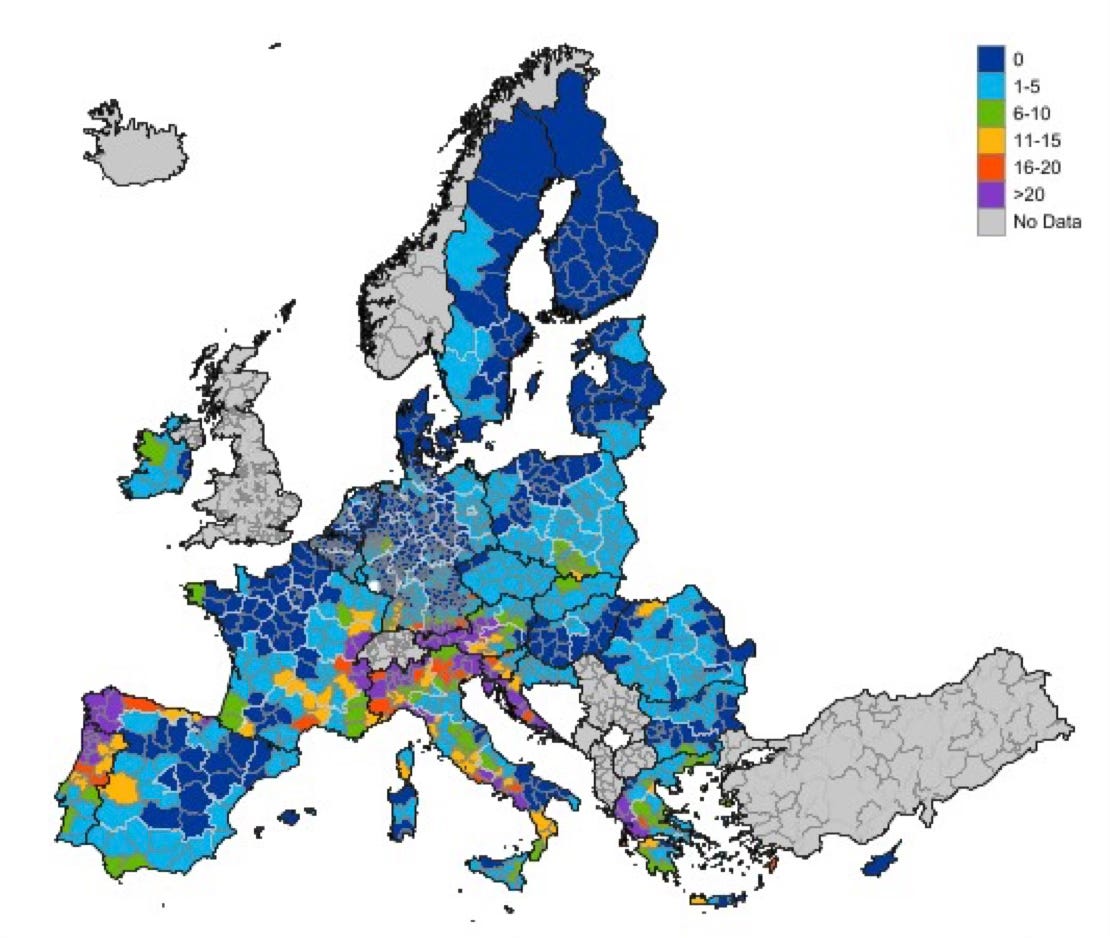
It has become commonplace to acknowledge that global warming brings with it more frequent droughts, heatwaves, and floods. Techno-optimists think we can deal with these extreme weather events by investing in adaptation technologies like flood defences. But what are the true costs of these investments?
A study from the ECB examined the multi-year impact of extreme weather events across different regions of the EU. Crucially, they went down to the subnational level at 1,160 so-called NUTS Level 3 regions. The chart below gives you an idea of these regions and how many floods were registered in each region between 1995 and 2022.
Flood events in EU NUTS 3 regions
Source: Usman et al. (2024)
This level of detail allowed the researchers to study not only how the region dealt with the extreme weather events, but also how poorer vs. richer regions, hotter vs. colder regions, etc. dealt with them.
As for floods, there is mostly good news. My second chart today shows the average change in total factor productivity (left) and economic output (regional GDP, right) developed in the five years after a flood. As you can see, there was no long-term impact on economic output, but productivity increased.
This indicates that after a flood destroys an area, people are building back better with newer technologies and new machinery, thus increasing productivity and making up for the lost output from the flood disaster.
Productivity (TFP, left) and economic output (local GDP, right) after a flood disaster
Source: Usman et al. (2024)
Good news then. Not quite. This average result is distorted by the rich regions which have the money to buy back better and see their productivity and local output grow, while poorer regions tend to lose output in the years after a flood because they don’t have the money to upgrade their technology. But at the very least, it shows that we can deal with floods by throwing enough money at the problem.
This is not the case with droughts and heat waves. If a region is hit by a heat wave, every additional degree centigrade of heat reduces local GDP by 0.26%. If the heat wave hits in summer, when it is already hot, the reduction is even larger at c. 0.5% for every degree centigrade. On the plus side, however, a heat wave in winter increases local output because outdoor activities like construction can continue and are not interrupted by cold weather.
However, there are long-term effects that go beyond the initial impact on the output I just mentioned. Four years after a heatwave hit a region, the local economic output is on average 1.4% lower than in an otherwise similar region that has not experienced a heatwave.
Productivity (TFP, left) and economic output (local GDP, right) after a heatwave
Source: Usman et al. (2024)
This drop in output is apparently due to a decline in the local population. People who experience a severe heatwave tend to move to other regions, partly because they lose their livelihood and partly because they no longer want to live in a region where temperatures have become unbearable for them for at least part of the year. However, the largest cause of this loss of output seems to be that the region invests capital in climate change adaptation rather than the modernisation of infrastructure. And because climate change adaptation is less productivity-enhancing than a modernisation of infrastructure, output growth drops for regions hit by a heatwave.
The situation gets even worse for a drought. Because droughts are extended periods of hardship that are particularly damaging to agriculture but also services like tourism, the long-term impact on economic output is even larger than for heatwaves at an average of 2.4% after four years. Again, necessary investments in the modernisation of infrastructure are superseded by more urgent investments in drought defences which are less productive. As a result, long-term productivity growth drops and with it economic growth.
Productivity (TFP, left) and economic output (local GDP, right) after a drought
Source: Usman et al. (2024)








 Newsifying your niche
Newsifying your niche

